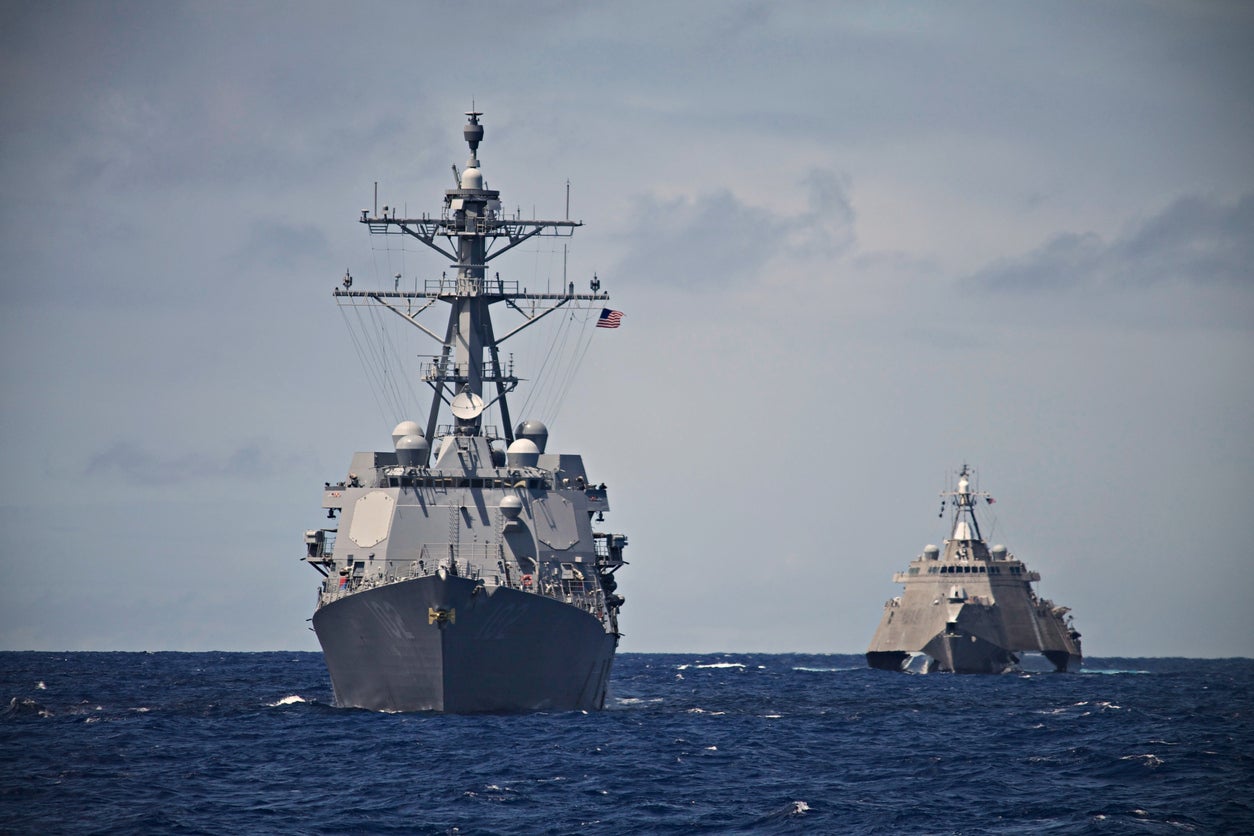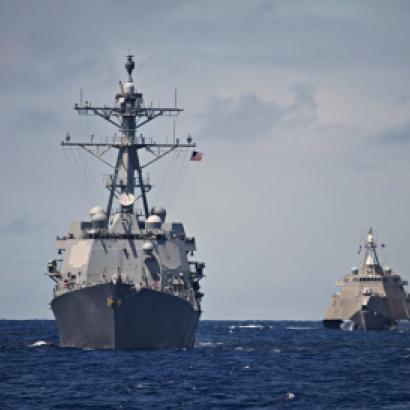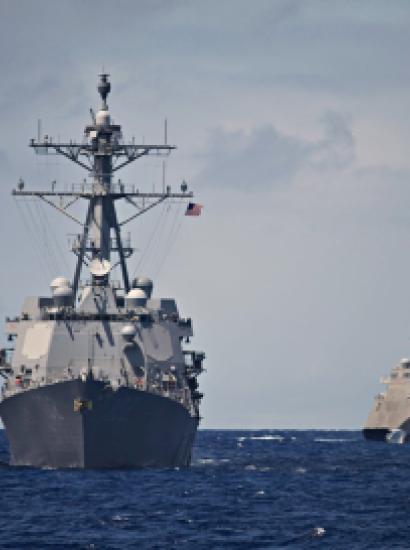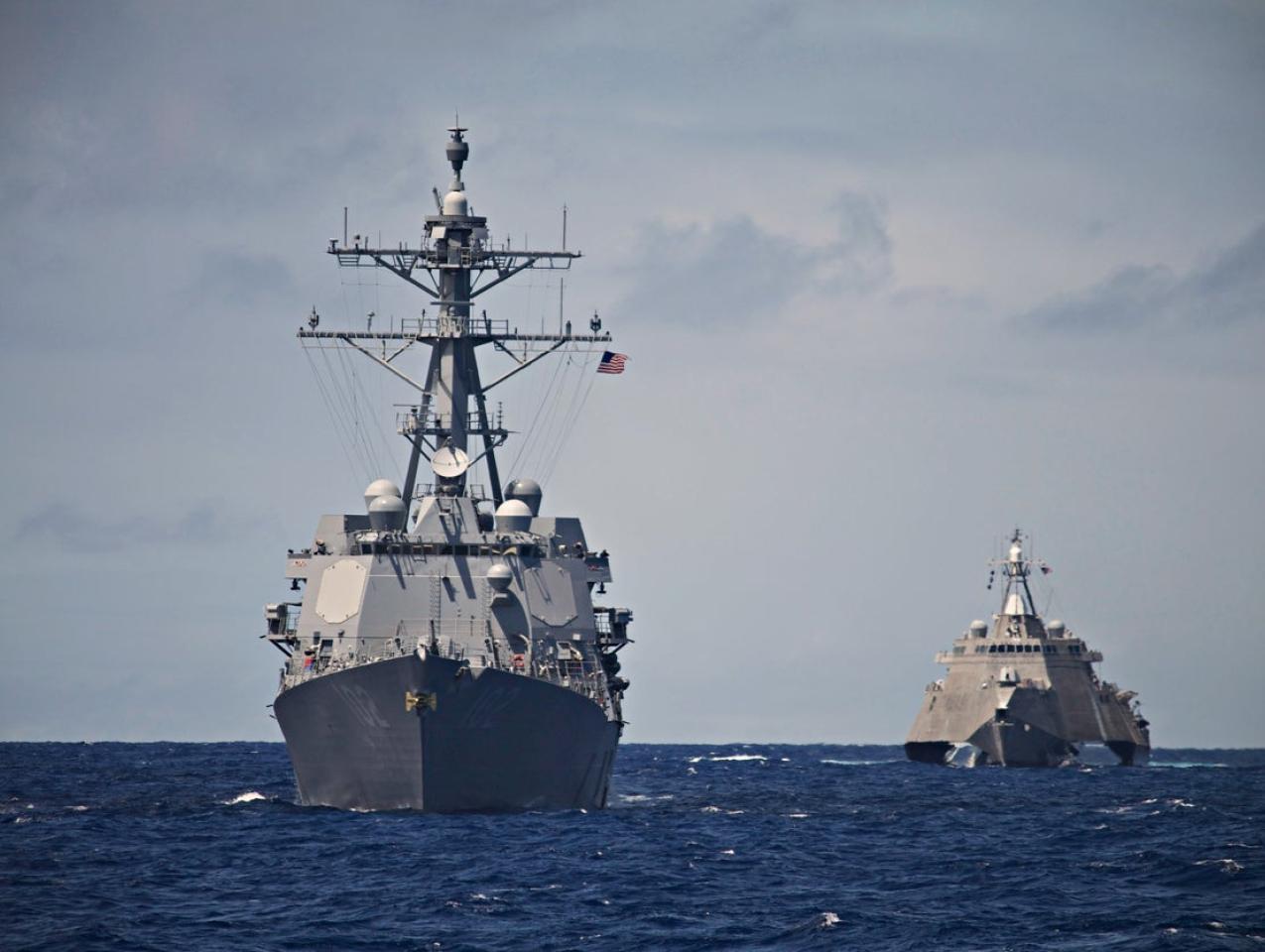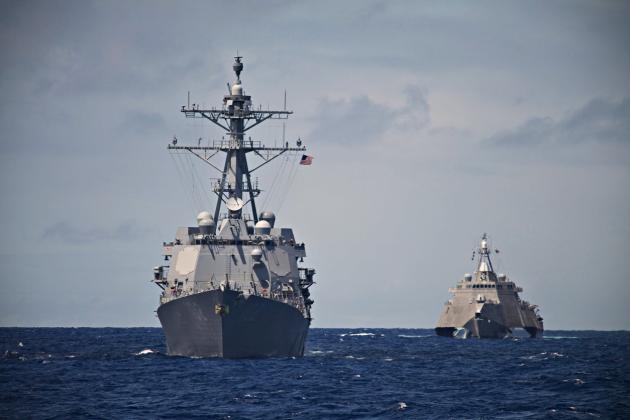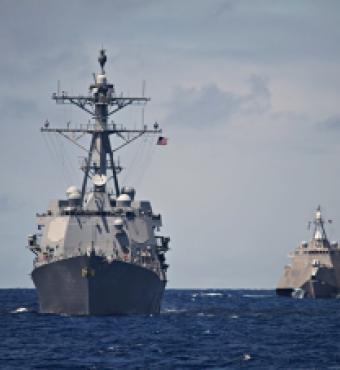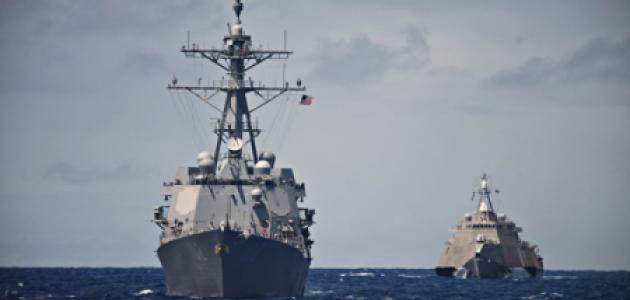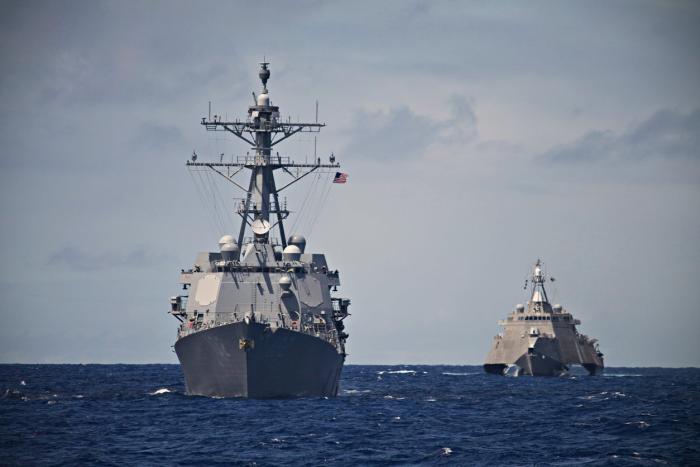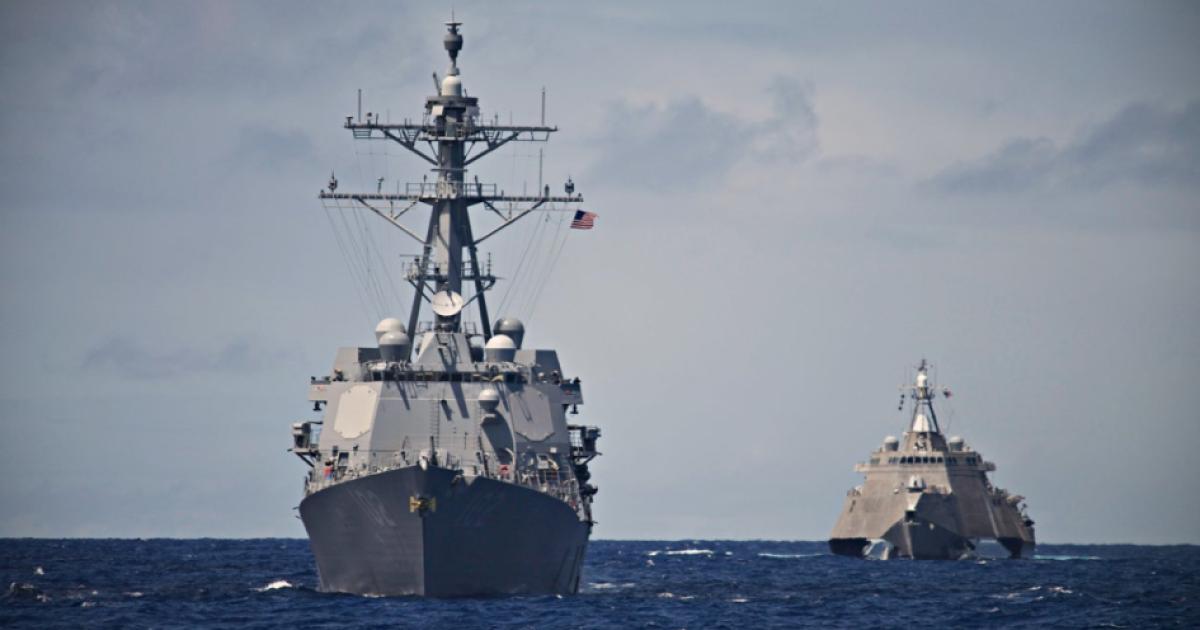- Middle East
When he departed the region for the last time in 1951, US Navy Captain Ernest Eller, who later in life became known as one of the Navy’s great historians, wrote the Chief of Naval Operations, “Great nations are stirring, and great events are shaping up in this part of the world. I hope the United States will comprehend them and will be equal to the opportunity.” Recent events raise more than a few questions as to whether Captain Eller’s hopes have been fulfilled or dashed.
As is the case with so much of early American foreign relations, the US Navy had a significant role in establishing the nation’s presence and developing its interests in the Middle East. From the visit of the sloop-of-war USS Peacock and the schooner Boxer to the coast of Oman in 1833 to establish a commercial treaty with the local sultan, to Commodore Robert Shufeldt’s port call in Basra in 1879, to Franklin D. Roosevelt’s impromptu meeting with King ibn-Saud on the cruiser Quincy in the Suez Canal’s Great Bitter Lake in 1945, American interests in the region were driven by free trade and protection of a free sea with open lines of commercial trade. Early on, this trade focused on the goods flowing out of India and east Asia, but by the 20th century the Middle East’s ample supplies of oil had transformed the region, raising its profile with the United States in general, and the US Navy in particular. Still, U.S. interests remained predominantly economic, and not strategic during this period.
While the British Royal Navy had understood the crucial importance of the region’s energy deposits early in the 20th century as it converted its fleet from coal to oil, it wasn’t until local refinery capacity expanded following World War II that the US Navy, then with over a thousand ships in its fleet, came to understand and prioritize the Middle East. By June 1947, over half of the Navy’s global fuel supply originated from Saudi and Bahraini refineries with US Navy oilers routinely flowing in and out of the Arabian Gulf. Additionally, Soviet movements into Iran following the war and the rising geo-political competition and instability associated with the Cold War shifted the United States’ interest from the economic realm to the strategic, as American policy makers including President Harry Truman and Secretary of Defense James Forrestal made a reappraisal of US commitments. Accordingly, beginning in January 1948, Task Force 126, U.S. Naval Force, Persian Gulf, was established near Bahrain. This new, forward based Navy command, quickly evolved over the next six years into what was called “US Navy Middle East Force” under the command of a two-star rear admiral embarked upon a flagship with two accompanying destroyers permanently assigned to him. This force operated from the British Royal Navy base at Bahrain.
Since the Roosevelt – Ibn Saud meeting in 1945, the region has been a center of great political and religious turmoil. The re-establishment of Israel as a Jewish homeland incensed Muslim nations of all sects and cultural origins, leading to several regional wars both directed at Israel and between local regional actors. Iran, the inheritor of the great Persian culture, had provided some modicum of regional stability until its own descent into radicalized chaos following the rise of the Shia-led Islamic Republic, which brought with it cries for “Death to the American Satan.” The domestic cultural and religious shift in Iran led to a war with Iraq, which in turn led to that nation’s rapid evolution into an aggressive regional Sunni power, and its subsequent invasion and occupation of Kuwait. Like dominos falling, each of these changes led in turn to deeper involvement on the part of the United States in the region and closer ties with other actors, Saudi Arabia, Bahrain, the United Arab Emirates, and Jordan, most of whom fell into the Sunni camp. US military presence grew from the meager flagship and two destroyers of 1949, to a continuous deployment of a least one super carrier strike group in the Gulf, composed of a carrier, two cruisers, two destroyers and two frigates, as well as two full land divisions routinely stationed in the region with the Air Force rotating tactical wing in and out of the area as well.
Commencing in 2003, the nearly two-decade long war in Iraq seemed to prove Captain Eller aprophet when he foretold that “Great nations are stirring and great events are shaping up in this part of the world.” However, more recently, first the Obama administration and then its lesser progeny, the Biden administration, failed to pay sufficient attention to Eller’s dependent clause, “I hope the United States will comprehend them and will be equal to the opportunity.” These two administrations have been driven by the beliefs on the part of President Obama that the decline in relations with Iran were as much the responsibility of the United States as it was Iran’s, and that there was strategic value in recapturing a balance in the United States’ approach to the region in terms of ties to both the Shia and Sunni Muslims. Both administrations have consistently sought to open a dialogue with the Iranian Islamic Republic. They have done this despite Iran’s continued support for state-sponsored terrorism against the West in general and the United States in particular. Also, they have pursued this strategy despite the obvious corrosive damage this initiative is causing to other relationships, built up over forty years, in the region.
Today, in the sunset of the United States’ commitment to the region, the ground troops have rotated home, the Air Force’s deployed aircraft have dwindled to less than a full tactical squadron and the Navy now routinely gaps Central Command’s requirement for a continuous carrier in the region for several months. In fact, the only permanent naval forces to be found within the Arabian Gulf are a small handful of coastal patrol craft, each nearing decommissioning, that make their home in Bahrain, although the Navy does retain a permanent three-star fleet command there. Such a force posture is perhaps appropriate in the face of the patrol boats of the Iranian Revolutionary Guard Corps, but it fails to either assure our allies and partners in the area or represent a sufficient deterrent force should enemies choose to strike.
If the current administration wished to address and correct the current strategic shortfall in the region, it should begin by fully assessing the environment. US interests in the region are no longer dominated by energy – the nation has sufficient reserves of its own – but its commitment to the concepts of free trade and freedom of navigation, the concepts which led the US Navy to the region in the 19th century, remain central to US foreign policy. As such our national interests there are predominantly maritime, and the threat also lies on and over the seas. Any move by a local Middle East actor or even an outside power, such as China, to compromise or curtail free movement over the seas to assure their own local control of the energy trade would have a cascading effect that would impact US interests across the globe. Understanding this, we can make recommendations as to the proper military force structure.
Because the United States no longer has either the appetite nor the strategic imperative to consistently project power ashore, it presently doesn’t need a persistent super carrier in the region, but such a force should be available to surge from either Atlantic or Pacific deployed forces. In the Arabian Gulf region, and in the broader Indian Ocean, the nation’s interests can best be served by the rotation of smaller littoral combat ships or the Navy’s new Constellation-class frigates, which will be entering the fleet soon. These vessels are small enough to patrol the smaller, shallower ports that dominate the geography of the region, but equipped with guns and missiles, are powerful enough to decisively defeat regional actors who might wish to attack the interests of the United States and its allies in the Middle East.
In the beginning, the mission of the Navy’s Middle East Force was “to demonstrate, by visiting friendly countries in this far-away area, the continuing interest of the United States in these countries and the desire of the United States to maintain good relations with them.” As we first stabilize and then seek to rebuild our reputation in the region, in the hope of strengthening ties with local partners along the lines of the Abraham Accords, the nation would be wise to return to the basic missions that characterized our original commitment to the region.
Dr. Jerry Hendrix, PhD, CAPT, USN (Ret), Senior Fellow, Sagamore Institute.







